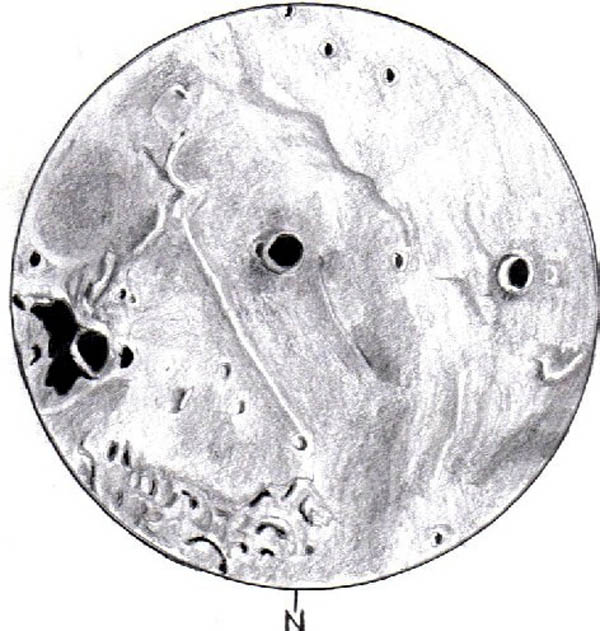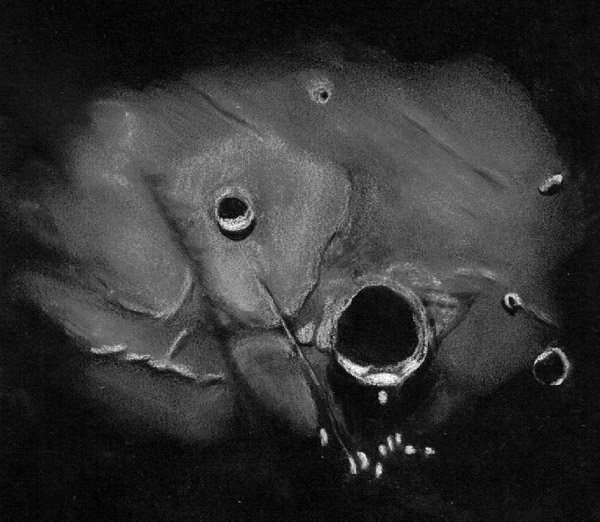In the morning hours before sun-up the early waning crescent moon was superimposed
on the firmament just west of the Pleiades. I was somewhat transfixed by this
scene but I was set up to sketch “straight wall” on the floor of the lunar Sea of
Clouds. From the eastern edge of Mare Nubium you can see the Triplet craters
Thebit (57 km), A and L. Next moving westward is the Imbrian escarpment Rupes
Recta , not a true wall in the usual sense but on one side standing more than 300
meters high at some points and 114 km in length. The scarp face would be visible
from crater Birt (17 km) to the west, the youngest of the larger craters sketched
here. Touching the rim of Birt to the east is Birt A. Continuing westward we see
Rima Birt a 51 km rille from the Imbriam epoch. At the end of the rille to the
south, is tiny 3 km crater Birt F seen in this sketch. Finally sitting on a
wrinkle in the floor of the mare is crater Nicollet (15 km) a Eratosthenian epoch
impact scar.
Sketching:
For this sketch I used: white copy paper, graphite pencil and pen and ink
Contrast adjusted with Imageenhance software
Telesccope: 18 inch f/ 5 Dobsonian working at 222X (9mm ocular)
Date: 8-16-2006 9:30-10:35 UT
Temperature: 17°C ( 62°F)
Clear, calm
Seeing: Antoniadi III
Colongitude 178 °
Lunation 22.3 days
Illumination 45.9%
Frank McCabe
Category: rille
Between Serenity and Tranquility
Craters Plinius and Dawes
After more than 23 days of very cold, cloudy, winter weather an approaching warm front got me out under the moon and stars on this clear, transparent night of good seeing. I centered the telescope field of view on craters Plinius and Dawes near the lunar terminator. This is the region I selected for my sketching. Plinius is the largest (43km) crater in the sketch. Its central peak and irregular, cratered floor are hidden in darkness but a hint of its terraced walls can be seen on the illuminated inner west margin. Further to the west the peaks near Promontorium Archeruia are catching the rising sunrays. About 55 km to the south of Plinius is crater Ross, a 26 km diameter crater identified only by its sunlit rim. This crater rests in the Sea of Tranquility. To the northeast of Plinius near the edge of the Sea of Serenity is the 19 km crater Dawes, its floor mostly in shadow. Directly to the north of Plinius the rilles of Plinius were clearly visible. In addition a small part of Dorsum Nicol is also seen. All of these features are positioned on the dark colored lavas at the boundary between the two above mentioned seas. The grazing sunlight helped to enhance the changes in topography.
Frank McCabe
Sketch details:
For this sketch I used: black Strathmore 400 Artagain paper 9”x12”, white and
black Conte’ pastel pencils and a soft leather blending stump.
Telescope: 10 inch f/ 5.7 Dobsonian and 6 mm eyepiece
Date: 2-23-2007 1:05-1:45 UT
Temperature: 0C ( 32F)
Clear, calm
Seeing: Antoniadi II
Colongitude 339 degrees
Lunation 5.4 days
Illumination 35.7%



